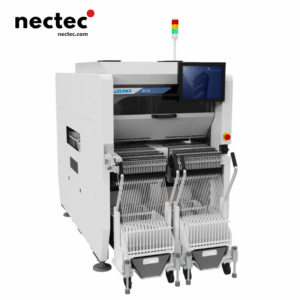W ostatnich latach producenci na całym świecie stanęli przed wyzwaniem nadążenia za szybkim postępem technologicznym, szczególnie w sektorze elektronicznym. Wraz ze stale rosnącym popytem na produkty wyższej jakości i szybsze czasy realizacji, producenci w Chinach zwrócili swoją uwagę na maszyny do umieszczania diod LED. Te zaawansowane maszyny rewolucjonizują sposób, w jaki komponenty LED są zintegrowane z urządzeniami elektronicznymi, zwiększając wydajność, dokładność i rentowność na całym świecie.
Zrozumienie maszyn do umieszczania diod LED
Maszyny do umieszczania diod LED, znane również jako maszyny pick-and-place, to specjalistyczny sprzęt używany do montażu komponentów elektronicznych na płytkach drukowanych (PCB). Zaprojektowane specjalnie do obsługi diod elektroluminescencyjnych (LED), maszyny te są w stanie umieścić tysiące komponentów na godzinę z niezwykłą precyzją. Rozwój rynku oświetlenia LED dramatycznie zwiększył zapotrzebowanie na te maszyny, wspierając postęp i innowacje w ich projektach.
Mechanizm działania maszyn do umieszczania diod LED
Funkcjonalność maszyn do umieszczania diod LED opiera się na zaawansowanych technologiach robotyki i automatyzacji. Wykorzystują one szereg mechanicznych ramion, złożone algorytmy oprogramowania, a czasem nawet sztuczną inteligencję, aby zoptymalizować rozmieszczenie komponentów. Proces ten obejmuje:
- Weryfikacja: Przed rozpoczęciem procesu montażu urządzenie weryfikuje specyfikacje komponentów LED, aby upewnić się, że spełniają one wymagane kryteria.
- Wybór: Pobiera komponenty LED z podajnika lub tacy za pomocą przyssawek lub chwytaków.
- Umieszczenie: Następnie maszyna precyzyjnie umieszcza diody LED w wyznaczonych miejscach na płytce drukowanej.
- Weryfikacja umieszczenia: Po umieszczeniu urządzenie może przeprowadzić kontrolę wzrokową w celu zapewnienia dokładności.
Wpływ na wydajność produkcji
Producenci, którzy integrują maszyny do umieszczania diod LED na swoich liniach produkcyjnych, doświadczają wielu korzyści, które zwiększają wydajność operacyjną. Oto kilka kluczowych zalet:
1. Szybkość i przepustowość
Tradycyjne metody umieszczania diod LED na płytkach PCB są pracochłonne i czasochłonne. W przeciwieństwie do nich, maszyny do umieszczania diod LED działają z dużą prędkością, znacznie zwiększając przepustowość. Pozwala to producentom dotrzymać kroku wymaganiom rynku i realizować zamówienia szybciej niż kiedykolwiek wcześniej.
2. Precyzja i kontrola jakości
Jednym z najważniejszych aspektów produkcji elektronicznej jest precyzja. Pojawienie się maszyn do umieszczania diod LED zwiększyło dokładność umieszczania komponentów w celu dostosowania ich do wąskich tolerancji, minimalizując błędy, które mogą prowadzić do kosztownych wad. Zautomatyzowane systemy inspekcji mogą oznaczać wadliwe rozmieszczenie, zapewniając wyższe standardy kontroli jakości.
3. Wydajność pracy
Podczas gdy początkowa inwestycja w maszyny do umieszczania diod LED może być znacząca, długoterminowe oszczędności na kosztach pracy są niezaprzeczalne. Automatyzując proces umieszczania, producenci mogą przenieść zasoby pracy do innych obszarów, co prowadzi do ogólnej poprawy wydajności w zakładzie.
Rozwój maszyn do umieszczania diod LED w Chinach
Jako największy na świecie producent wyrobów elektronicznych, Chiny odgrywają kluczową rolę na rynku technologii montażu LED. Szybkie przyjęcie rozwiązań oświetleniowych LED i wzrost popytu na elektronikę spowodowały znaczne inwestycje w technologie produkcyjne, w tym w maszyny do umieszczania diod LED.
Innowacyjność i przewaga konkurencyjna
Chińscy producenci są nie tylko konsumentami istniejących technologii, ale także innowatorami. Na zaciekle konkurencyjnym rynku firmy ścigają się, aby zwiększyć swoje możliwości produkcyjne. Wiele z nich opracowało własne modele maszyn do umieszczania diod LED, które mogą pochwalić się ulepszonymi funkcjami, takimi jak ulepszone interfejsy użytkownika i zwiększona elastyczność w celu obsługi różnych wielkości produkcji.
Wyzwania związane z wdrażaniem maszyn do umieszczania diod LED
Pomimo wyraźnych korzyści, producenci mogą napotkać wyzwania podczas integracji maszyn do umieszczania diod LED w swoich przepływach pracy. Potrzeba specjalistycznego szkolenia personelu, wysokie koszty początkowe związane z zakupem zaawansowanych maszyn i obawy związane z konserwacją mogą stanowić przeszkodę. Jednak przy zastosowaniu odpowiednich strategii, wyzwaniami tymi można skutecznie zarządzać.
Szkolenie i rozwój umiejętności
Przejście na systemy zautomatyzowane wymaga przeszkolenia personelu w zakresie obsługi i konserwacji tych zaawansowanych technologicznie maszyn. Wdrożenie dokładnych programów szkoleniowych ma zasadnicze znaczenie dla maksymalizacji potencjału maszyn i minimalizacji przestojów.
Konserwacja i przestoje
Regularna konserwacja ma kluczowe znaczenie dla utrzymania optymalnej wydajności maszyn do umieszczania diod LED. Producenci muszą inwestować w wykwalifikowanych techników, którzy mogą serwisować maszyny i wdrażać programy konserwacji zapobiegawczej, aby zmniejszyć ryzyko przestojów.
Przyszłe trendy w technologii umieszczania diod LED
Innowacje związane z maszynami do umieszczania diod LED są nieustające. W miarę jak producenci dążą do maksymalizacji wydajności i zdolności adaptacyjnych linii produkcyjnych, na horyzoncie pojawia się kilka trendów:
1. Inteligentna integracja technologii
Wraz z rozwojem Internetu rzeczy (IoT), integracja inteligentnych technologii w maszynach do umieszczania diod LED staje się coraz bardziej powszechna. Pozwala to na monitorowanie i analizę w czasie rzeczywistym, umożliwiając producentom optymalizację harmonogramów produkcji i strategii konserwacji predykcyjnej.
2. Zrównoważony rozwój środowiska
Wraz z rosnącą presją na bardziej ekologiczne praktyki produkcyjne, możemy spodziewać się, że postępy w maszynach do umieszczania diod LED będą koncentrować się na zrównoważonym rozwoju. Może to obejmować energooszczędne maszyny i procesy, które zmniejszają ilość odpadów podczas produkcji.
3. Możliwość adaptacji i modułowa konstrukcja
Wraz ze skracaniem się cykli życia produktów, producenci potrzebują systemów produkcyjnych, które można szybko dostosować do zmieniających się potrzeb. Przyszłe maszyny do umieszczania diod LED mogą mieć bardziej modułową konstrukcję, umożliwiając firmom łatwą aktualizację lub modyfikację komponentów w miarę rozwoju technologii.
Wnioski
Ponieważ technologia LED wciąż ewoluuje i rozwija się, nie można bagatelizować znaczenia wydajnych procesów montażowych. Maszyny do montażu diod LED stanowią fundamentalną zmianę w produkcji elektronicznej w Chinach i poza nimi. Dzięki ciągłym postępom i skupieniu się na automatyzacji, przyszłość rysuje się w jasnych barwach dla producentów chcących poprawić wydajność i utrzymać przewagę konkurencyjną na dynamicznym rynku elektroniki.






